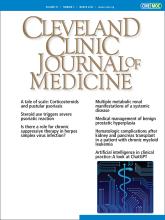A 69-year-old man with well-controlled plaque psoriasis who presented to the emergency department for unilateral wrist pain was found to have calcium pyrophosphate deposition disease. Symptoms improved with a 7-day course of oral prednisone 30 mg twice daily without tapering. Attempts were made to control his symptoms with other recommended treatments for calcium pyrophosphate deposition disease, including colchicine and intra-articular steroid injection, but the pain recurred and only prednisone provided relief. Nonsteroidal anti-inflammatory drugs were not started because the patient was on long-term anticoagulant therapy. Two rounds of prednisone 20 mg twice daily for 5 days with a 5-day taper to 7.5 mg daily were prescribed, with an intention to continue until a follow-up visit with a rheumatologist could be scheduled.
After tapering the second round of prednisone, the patient developed a circular plaque bordered with pustules that expanded centrifugally (Figure 1). Punch biopsy results, in addition to the patient’s relevant clinical history, were consistent with generalized pustular psoriasis (GPP). Topical clobetasol ointment 0.05% was started due to patient preference, but the painful pustular plaques spread to his extremities and torso.
After tapering prednisone, the patient developed a circular plaque bordered with pustules superimposed on erythematous skin. The pustules expanded centrifugally.
Severe pain and fever led him to present to the emergency department where at presentation 50% of his body surface was affected by pustular lesions (Figure 2). Additionally, his left lower leg was tender, erythematous, and warm, suggestive of cellulitis. On admission, laboratory tests revealed an elevated erythrocyte sedimentation rate of 27 mm/hr (reference range 0–20 mm/hr) and hypoalbuminemia of 3.6 g/dL (4.0–4.9), but a normal white blood cell count of 10.2 × 109/L (4.5–11.0), normal levels of aspartate aminotransferase at 12 U/L (< 41) and alanine transaminase at 21 U/L (< 41), and no electrolyte abnormalities.
Widespread generalized pustular psoriasis involved both lower extremities and the torso.
Administration of cyclosporine 250 mg twice a day and continued topical clobetasol 0.05% ointment for GPP in conjunction with vancomycin for lower-extremity cellulitis led to rapid improvement during his 5-day admission. He left the hospital on the same cyclosporine dose and continued to improve. About 3 months after starting cyclosporine, he was tapered off the medication after changing to risankizumab.
GENERALIZED PUSTULAR PSORIASIS
GPP is an uncommon but severe form of psoriasis vulgaris characterized by widespread eruption of sterile neutrophil-filled pustules superimposed on erythematous skin.1,2 Skin findings are often accompanied by systemic symptoms such as arthralgias, myalgias, and fever. Common abnormalities on laboratory tests include leukocytosis with neutrophilia and elevated erythrocyte sedimentation rate.1–3 Hepatic function, hypoalbuminemia, and electrolytes are less commonly affected.1–3 Patients typically have a history of psoriasis.1,4,5
Though most cases of GPP are idiopathic, triggers include medication withdrawal (particularly corticosteroids), infection, pregnancy, hypocalcemia, and sun exposure.1,5 In this patient’s case, the history suggests the psoriatic flare developed prior to the onset of cellulitis, and thus the infection was likely a complication rather than an inciting factor.
The differential diagnosis for GPP includes acute generalized exanthematous pustulosis, subcorneal pustular dermatosis, immunoglobulin A pemphigus, and pemphigus foliaceus, all of which can present with similar skin manifestations.2,5 Patients with acute generalized exanthematous pustulosis rarely have a history of psoriasis, are eosinophilic on workup, and develop symptoms abruptly after the initiation of new medications. After the inciting drug is stopped, patients with acute generalized exanthematous pustulosis rapidly improve.2,5 Subcorneal pustular dermatosis rarely causes systemic manifestations.6 Acute generalized exanthematous pustulosis, subcorneal pustular dermatosis, immunoglobulin A pemphigus, and pemphigus foliaceus can all be distinguished histologically, and skin biopsy can help differentiate or confirm the diagnosis.2,5,6
First-line treatment for GPP includes acitretin, cyclosporine, methotrexate, or infliximab. Targeted medications including interleukin-17, interleukin-23, and interleukin-36 inhibitors have also recently been shown to be effective.4,7
RISK ASSESSMENT
Prescribing of systemic corticosteroids is ubiquitous across specialties. Practitioners must be aware of the potential risk of triggering a GPP flare in patients with psoriasis, and other recommended treatments should be attempted. Our patient had failed or had contraindications to typically recommended treatments for calcium pyrophosphate deposition disease, except for systemic corticosteroids. Tapering vs not tapering prednisone has not been shown to reduce the risk of triggering GPP.1 Ultimately, when balancing the risks and benefits of systemic corticosteroids, practitioners must include the risk of triggering GPP in patients with psoriasis. This necessitates shared decision-making and patient education, including information on warning signs and close monitoring.
DISCLOSURES
The authors report no relevant financial relationships which, in the context of their contributions, could be perceived as a potential conflict of interest.
- Copyright © 2024 The Cleveland Clinic Foundation. All Rights Reserved.








